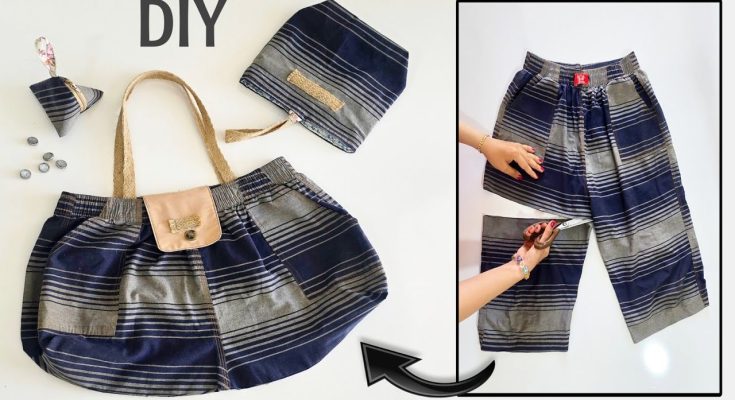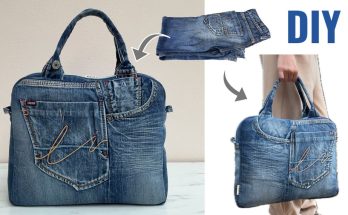It’s fantastic that you’re looking to upcycle old pants into a handbag! This is a wonderfully sustainable and creative project. Old pants, especially jeans, offer a durable and often unique base for a bag, complete with built-in features like pockets, seams, and sometimes even a zipper fly that you can incorporate into your design.
This guide will focus on transforming a pair of old jeans (or similar sturdy woven pants like corduroy or canvas) into a stylish and practical handbag. We’ll create a structured bag with a flat bottom, a neat lining, and the option to integrate original pant features.
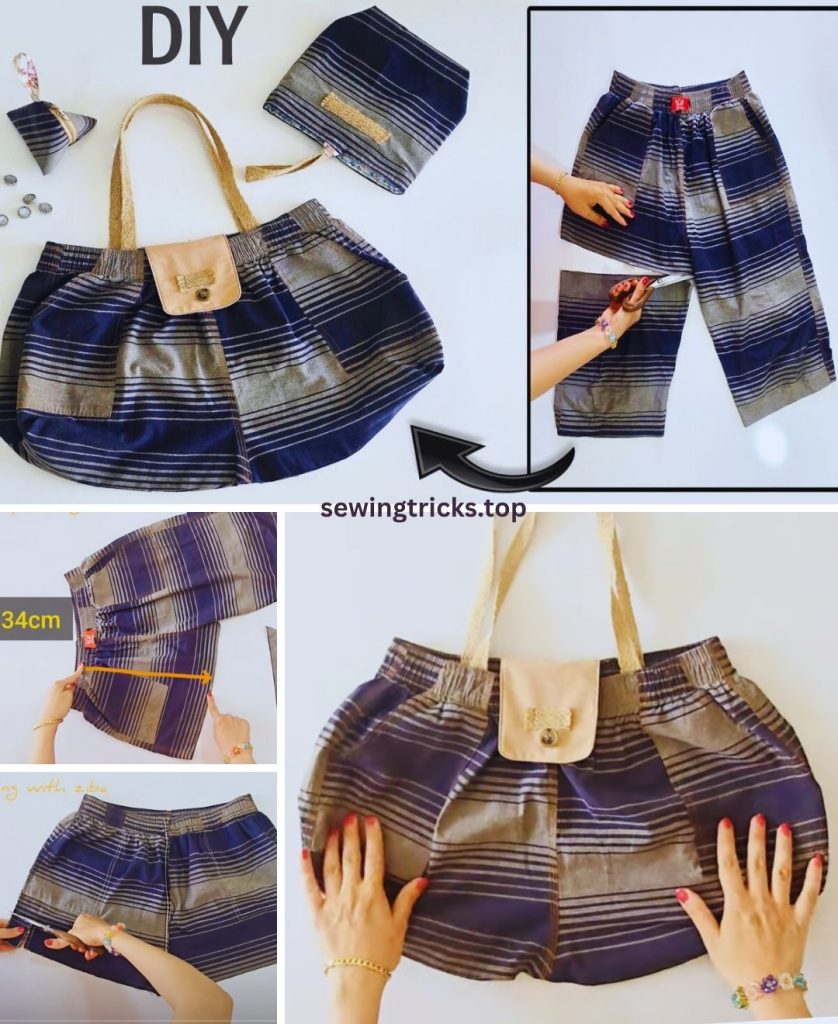
How to Sew a Handbag by Upcycling Old Pants
This detailed tutorial will guide you through each step, helping you create a unique, sturdy, and personalized handbag. Working with repurposed fabric requires a bit of adaptability, but the result is always worth it!
I. Planning Your Upcycled Handbag
Thoughtful planning is key, especially when working with repurposed materials.
- Pant Choice:
- Jeans are Ideal: Their durability, classic look, and existing features (pockets, belt loops, waistband, zipper fly) are perfect for upcycling into a bag. Non-stretch or low-stretch denim is easiest to work with.
- Other Sturdy Woven Pants: Corduroy, canvas, or cotton twill pants also work well. Avoid very thin or stretchy fabrics.
- Cleanliness: Ensure the pants are clean and ironed before you start.
- Bag Style & Size:
- Rectangular or Tapered Tote-Style: This is the most common and easiest shape to create from pant legs. A good medium size might be around 12-14 inches wide x 10-12 inches tall x 3-4 inches deep (30-35 cm x 25-30 cm x 7.5-10 cm).
- Integrating Pant Features: Decide if you want to feature a back pocket on the exterior, use the waistband for the bag’s top, or incorporate original seams.
- Handles/Strap:
- Fabric Handles: Made from the pant legs themselves or a coordinating fabric.
- Webbing Handles: Sturdy cotton or polyester webbing.
- Leather or Faux Leather Straps: Can be purchased for a more professional look.
- Closure (Optional): Magnetic snap, zipper, or a simple tab with a button. For simplicity, we’ll suggest a magnetic snap.
II. Gather Your Materials
Having everything ready ensures a smooth and enjoyable sewing process.
- Old Pants: 1 pair of clean, ironed, sturdy woven pants (jeans are great!).
- Lining Fabric: 1 to 1.5 yards (0.9 to 1.4 meters) of medium-weight cotton, canvas, or poly-cotton. Choose a durable fabric that complements your pant fabric.
- Heavy-Duty Fusible Interfacing (ESSENTIAL for Structure!): 1 to 1.5 yards (0.9 to 1.4 meters) of medium to heavyweight fusible interfacing (e.g., Pellon 809 Decor Bond, Pellon 71F Peltex II Ultra Firm). This is critical for giving your bag professional structure and preventing it from being floppy.
- Handle Material:
- For Fabric Handles: Additional fabric from pant legs, or 1/2 yard (0.45 meters) of coordinating fabric.
- For Webbing Handles: 1 to 1.5 yards (0.9 to 1.4 meters) of 1-inch or 1.5-inch wide cotton webbing.
- Magnetic Snap (Optional): 1 set, about 3/4 inch (1.9 cm) diameter.
- Matching Thread: Strong, all-purpose polyester thread. Consider a contrasting color (like gold or orange) for a classic jean topstitch look.
- Basic Sewing Supplies:
- Sewing Machine: Must handle thick layers. A walking foot is highly recommended.
- Heavy-Duty Needles: Denim needles (size 90/14 or 100/16) are essential. Have spares!
- Sharp Fabric Scissors or Rotary Cutter and Mat
- Quilting Ruler or Measuring Tape
- Fabric Chalk or Mark-B-Gone pen
- Plenty of Wonder Clips (superior to pins for thick denim/multiple layers).
- Iron and Ironing Board (crucial for fusing interfacing and pressing seams).
- Seam Ripper (your most valuable tool for disassembling pants!).

III. Plan Your Cuts & Prepare Your Pant Panels
This stage involves disassembling your pants and carefully cutting the pieces.
A. Determine Your Bag Dimensions (Example): Let’s use an example: 12 inches wide x 10 inches tall x 3 inches deep. We’ll use a 1/2-inch (1.27 cm) seam allowance throughout.
B. Calculate Panel Sizes:
- Main Body Panel Width: Finished Width + Finished Depth + (2 * Seam Allowance) = 12″ + 3″ + 1″ = 16 inches
- Main Body Panel Height: Finished Height + Finished Depth + (2 * Seam Allowance) = 10″ + 3″ + 1″ = 14 inches
C. Disassemble Your Pants:
- Cut Off Legs: Cut off the legs just below the crotch seam.
- Open Leg Seams: Use your seam ripper to carefully open up both the inseam (inner leg seam) and the outseam (outer leg seam) of each leg. This will give you large, flat panels of fabric. Iron these pieces flat.
- Harvest Pockets (Optional): If you want to use original back pockets on the exterior, carefully cut them out, leaving enough fabric around them to attach securely.
- Save Waistband (Optional): If you want to incorporate the waistband as the top of your bag, carefully cut it off the pants, keeping it intact.
D. Create Large Fabric Panels (Piecing is Common):
For a bag of this size, you’ll almost certainly need to piece fabric together from the pant legs to get panels wide enough.
- Plan Your Layout: Lay out your opened pant pieces. Arrange them to maximize cuts. Consider combining different washes for a patchwork look if using jeans.
- Piecing Technique:
- Place two pant fabric pieces right sides together, aligning a long raw edge.
- Stitch them together using a 1/2-inch (1.27 cm) seam allowance.
- Press the seam open thoroughly to reduce bulk.
- Topstitch (Highly Recommended): On the right side of the fabric, sew two lines of stitching, one on each side of the seam line, about 1/8 inch (0.3 cm) away. This mimics the look of jean seams and adds strength.
- Continue piecing until you have fabric panels large enough for your final cuts.
E. Cut Your Fabric Pieces:
- Exterior Fabric Pieces:
- Main Body: Cut 2 rectangles, each 16 inches wide x 14 inches high.
- Lining Fabric Pieces:
- Main Body: Cut 2 rectangles, each 16 inches wide x 14 inches high.
- Interior Slip Pocket (Optional): Cut 1 rectangle, 8 inches wide x 10 inches high.
- Heavy-Duty Fusible Interfacing:
- Main Body: Cut 2 rectangles, each 15 inches wide x 13 inches high (1 inch smaller on all sides than your main panels).
- Handle Material (if using fabric): Cut 2 rectangles, each 3 inches wide x 20 inches long (adjust length for desired handle drop).
IV. Let’s Start Sewing Your Upcycled Handbag!
General Tips for Sewing Thick Fabric/Denim:
- Denim Needle: Always use a fresh, sharp denim needle (90/14 or 100/16).
- Walking Foot: If you have one, use it! It helps feed thick layers evenly and prevents skipped stitches.
- Go Slow: Stitch slowly, especially over bulky seams. You may need to hand-crank your machine over particularly thick areas.
- Wonder Clips: Use these generously instead of pins for thick fabric.
- Pressing: Press all seams open thoroughly to reduce bulk. Use a good, hot iron.
- Topstitching: Use a slightly longer stitch length (3.0-3.5mm) for all topstitching for a more professional and authentic look.
Step 1: Prepare Exterior Panels (Fuse Interfacing & Add Optional Pockets)
- Fuse Interfacing: Take the two Exterior Fabric Main Body Panels. Lay each one wrong side up on your ironing board. Center and fuse the corresponding interfacing piece to each, following manufacturer’s instructions. Press firmly and allow to cool.
- Add Exterior Pockets (Optional): If using, position and topstitch a harvested jean back pocket onto one Exterior Fabric Main Body Panel now (this will be the front of your bag), before sewing the panels together.
Step 2: Construct the Exterior Bag Body
We’ll use a 1/2-inch (1.27 cm) seam allowance for all seams.
- Place the two Exterior Fabric Main Body Panels right sides together, carefully aligning all raw edges.
- Clip securely along both side edges and the entire bottom edge. Leave the top edge open.
- Stitch from one top corner down that side, pivot sharply at the bottom corner, stitch straight across the bottom, pivot again, and stitch up the other side to the top corner. Backstitch at the beginning and end.
- Press your seams open thoroughly to reduce bulk.
Step 3: Box the Corners of the Exterior Bag
This creates the flat, structured bottom of your handbag.
- Lay the exterior bag body flat. The side and bottom seams should be pressed open.
- At one of the bottom corners, carefully bring the side seam and the bottom seam together, aligning them perfectly. This will naturally form a triangular shape.
- Measure from the tip of this triangle inward along the seam line a distance equal to half of your desired bag depth (e.g., for a 3-inch deep bag, measure 1.5 inches / 3.8 cm).
- Draw a straight line perpendicular to the seam at this measured point. This is your new stitching line.
- Clip firmly along this drawn line.
- Stitch precisely along the drawn line, backstitching securely at both ends.
- Trim the excess fabric from the corner, leaving about a 1/2-inch (1.27 cm) seam allowance beyond your new stitching line.
- Repeat this exact process for the other bottom corner of your exterior bag body.
- Result: Your exterior bag now has a defined, flat bottom. Keep it wrong side out.
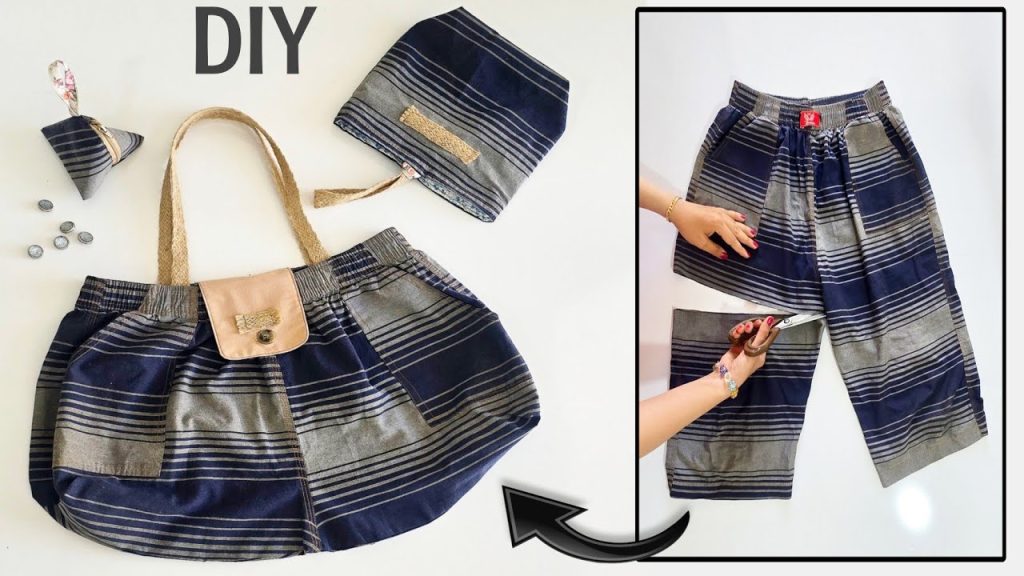
Step 4: Sew the Lining Bag Body (with Optional Pocket)
The lining is constructed almost identically to the main bag, with one crucial difference for turning.
- Prepare Interior Slip Pocket (Optional):
- Take your 8″ x 10″ pocket piece.
- Fold it in half, right sides together, so it’s 8″ x 5″. Stitch around three sides, leaving a 3-4 inch (7.6-10.2 cm) opening on the bottom. Trim corners.
- Turn the pocket right side out through the opening. Push out corners, press flat. Stitch the opening closed by machine (very close to the edge) or by hand using an invisible ladder stitch.
- Position and Attach Pocket: Take one of your Lining Fabric Main Body Panels. Position the pocket about 3-4 inches (7.6-10.2 cm) down from the top raw edge, and centered horizontally.
- Topstitch the pocket to the lining panel along its two sides and bottom edge. Stitch close to the edge. Reinforce the top corners of the pocket with a small triangle stitch or a few back-and-forth stitches.
- Sew Lining Body:
- Place the two Lining Fabric Main Body Panels right sides together, aligning all raw edges.
- Clip or pin along both side edges.
- CRUCIAL STEP: For the bottom seam, you must leave an opening! Stitch down one side seam. Then, for the bottom seam, stitch approximately 2-3 inches (5-7.6 cm) from one side, then leave a 4-6 inch (10-15 cm) unstitched gap in the middle of the bottom seam. This opening is absolutely essential for turning the entire bag right side out later. After the gap, stitch for another 2-3 inches (5-7.6 cm) to reach the other side seam. Backstitch well at the start and end of the stitched sections around your opening.
- Stitch up the second side seam.
- Press your seams open.
- Box the Corners of the Lining Bag: Box the corners of your lining bag using the exact same method you used for the exterior bag (refer back to Step 3).
- Result: Your lining bag is now fully constructed, with that important turning opening. Keep it wrong side out.
Step 5: Prepare and Attach Handles
A. If Using Fabric Handles (from pant fabric or coordinating):
- Take one handle strip (3″ x 20″).
- Fold it in half lengthwise, wrong sides together, and press firmly. Open it up.
- Fold each long raw edge in towards the center crease you just made, and press again.
- Fold the entire strip in half again along the original center crease. You should now have a long, flat handle that is about 3/4 to 1 inch (1.9-2.5 cm) wide with no raw edges visible. Press firmly along the entire length.
- Topstitch down both long sides of the prepared handle, about 1/8 inch (0.3 cm) from the edge. This secures all the folds and makes a neat, strong handle.
- Repeat this process for the second handle strip.
- Attach to Exterior Bag: Turn your exterior bag right side out. Lay it flat.
- Measure in from each side seam along the top raw edge by about 3-4 inches (7.6-10.2 cm). Mark these points with chalk.
- Position the raw ends of one prepared handle on the top raw edge of the bag at your marks. Make sure the handle itself is flat and not twisted. Pin securely.
- Stitch the handle ends in place. For a strong hold, sew a small square with an “X” inside it (an X-box stitch) for maximum reinforcement. Stitch within the 1/2-inch (1.27 cm) seam allowance, close to the edge.
- Repeat for the other side of the bag with the second handle.
B. If Using Webbing Handles:
- Cut your webbing into two equal lengths (e.g., two 18-20 inch / 46-51 cm pieces).
- Attach to Exterior Bag: Turn your exterior bag right side out. Lay it flat.
- Measure in from each side seam along the top raw edge by about 3-4 inches (7.6-10.2 cm). Mark these points.
- Position one raw end of the webbing on the top raw edge of the bag at one mark, with the webbing loop pointing down into the bag. Pin securely.
- Stitch the webbing end in place, using a square with an “X” inside it (X-box stitch) for reinforcement. Stitch within the 1/2-inch (1.27 cm) seam allowance, close to the edge. Repeat for all four webbing ends (two ends per handle).
Step 6: Attach Magnetic Snap (Optional)
If you’re adding a magnetic snap closure, install it on the exterior bag now, before joining the lining.
- Find the center of the front exterior panel along the top edge, about 1-1.5 inches (2.5-3.8 cm) down from the top. Mark the placement for one half of the snap.
- Repeat for the back exterior panel, ensuring the snaps will align when the bag is closed.
- Follow the manufacturer’s instructions for installing the magnetic snap. Typically, you’ll mark the prongs, cut tiny slits, push the prongs through the fabric, place a washer over the prongs, and bend them inwards to secure.
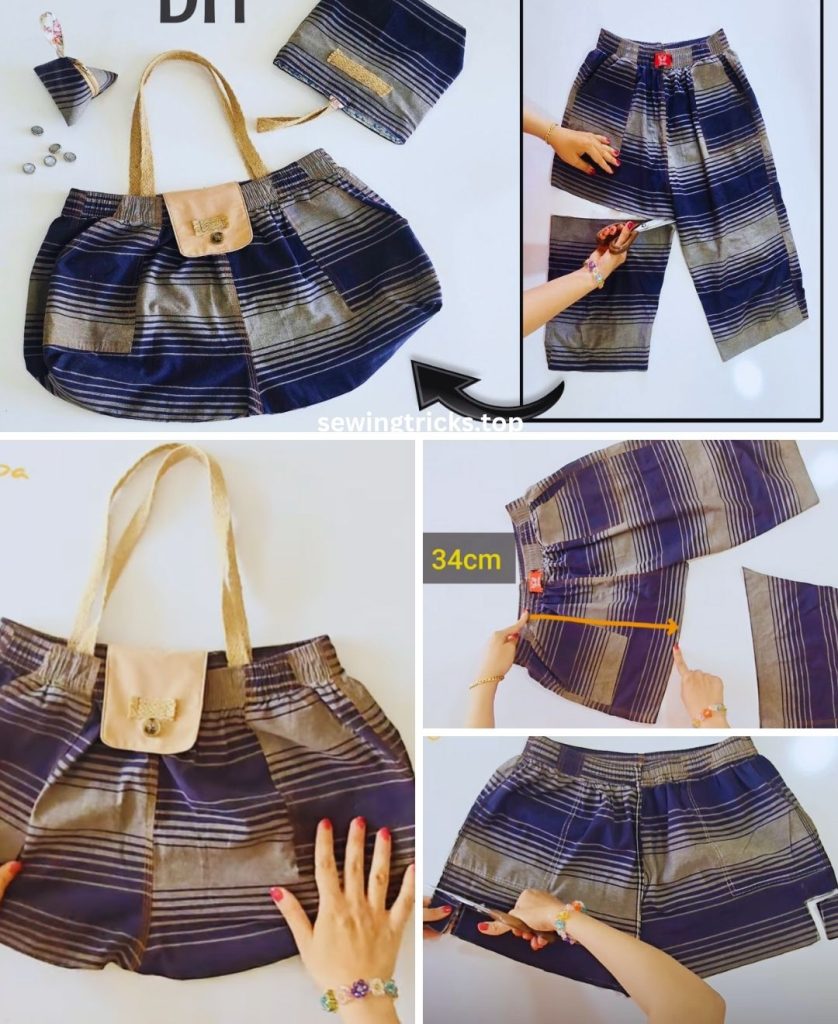
Step 7: Join the Exterior Bag and the Lining Bag (The “Bag-in-a-Bag” Method)
This clever technique encloses all raw edges at the top for a super clean and professional finish.
- Ensure your exterior bag is right side out, with handles attached and pointing down into the bag (and magnetic snap installed).
- Ensure your lining bag is wrong side out (and still has that turning opening at the bottom).
- Carefully insert the exterior baginto the lining bag.
- The right sides of both bags should now be facing each other.
- Align the side seams of the exterior bag with the side seams of the lining bag.
- Align the top raw edges of the exterior fabric and the lining fabric all around the entire opening of the bag. The handles and magnetic snap (if used) should be sandwiched between the layers, pointing down.
- Clip very securely all the way around this top edge, matching up seams precisely.
- Using your 1/2-inch (1.27 cm) seam allowance, stitch all the way around the entire top opening of the bag. Go slowly and carefully, especially when you go over the handle attachment points and snap. Backstitch at the beginning and end of your seam.
- Trim Bulk: Carefully trim the seam allowance at the top down to about 1/4 inch (0.6 cm) to reduce bulk inside the top edge.
Step 8: Turn Your Bag Right Side Out & Finish
This is the incredibly satisfying moment your upcycled handbag takes its final, beautiful shape!
- Reach through the opening you left in the bottom seam of the lining.
- Slowly and carefully pull the entire bag (exterior, lining, handles, snap – everything!) through this opening until it is completely right side out. Take your time, gently pushing out all the corners for a crisp, well-defined shape.
- Close the Lining Opening: Go to your ironing board. Press the raw edges of the opening in the bottom of the lining under by 1/2 inch (1.27 cm) so they meet neatly. Align these pressed edges and clip them together. Stitch this opening closed by machine (sewing very close to the folded edge for a neat finish) or by hand using an invisible ladder stitch for a truly seamless look.
- Now, push the lining down into the exterior bag.
- Final Press & Topstitch: Carefully press the entire top edge of the bag. Make sure the lining is fully tucked inside and isn’t peeking out over the top edge of the exterior fabric.
- For a super polished and durable finish, topstitch all around the entire top opening of the bag, about 1/8 inch (0.3 cm) from the edge. This final topstitching marries the lining to the exterior, helps the bag hold its shape, and creates a crisp, professional look. You can also sew a second row of topstitching about 1/2 inch (1.27 cm) from the top edge for added detail and stability.
Your unique, upcycled handbag is now complete! You’ve transformed old pants into a functional, durable, and stylish accessory that’s truly one-of-a-kind. Enjoy carrying your sustainable creation!
What other types of bags or sewing projects are you interested in trying?

